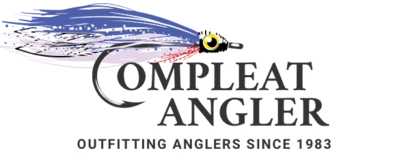Your Cart is Empty
FREE SHIPPING ON ORDERS OVER $75! (exclusions apply) / ALL TACKLE IN STOCK
Menu

FREE SHIPPING ON ORDERS OVER $75! (exclusions apply) / ALL TACKLE IN STOCK
Featured

Here you'll find the latest and greatest tackle that's new in stock.

Save big on some of the best names in the business. We have a variety of great deals on everything from waders, boots, rods and reels to terminal tackle.

Here you'll find the gear that our team of experts loves most.

Check out some of our best gear for Saltwater Anglers!
Fly Rods
Fly Reels
Fly Lines
Wading Gear
Clothing
Vests & Packs
Accessories
Flies
Fly Tying
Gifts & Books
Gift Guides

Every year we have the privilege of outfitting anglers all around the world. But as any serious angler knows, not all gear is created equal. Here are our picks for the best gear of the year, the items that set themselves apart from the fray.

As any serious angler knows it's hard to have a great day on the water if you're cold, wet, and uncomfortable. Here we've included the gear that's guaranteed to keep a smile on your face no matter what mother nature throws at you.

Finding great deals may seem tougher and tougher these days, but rest assured they are out there if you know where to look. This holiday season our team did a little of the legwork for you by rounding up some of our favorite deals on rods, reels, and everything in between.

Ah, the Trout Bum. You probably know one or two of these characters. The ones whose waders are always wet, who have bits of fly tying material perpetually stuck to them. If that sounds familiar, and if you have one on your shopping list this year, fear not. We've got you covered.

Saltwater anglers are a special breed, braving wind and waves to chase the fish they love. Here we've pulled together some of our favorite gear for your favorite saltwater angler, tried and tested by our customers and expert team here at the shop.

Ben Rinker Tags Upper Delaware River Trout
May 06, 2017 2 min read
Last year, legendary Catskill guide Ben Rinker from East Branch Outfitters introduced and was approved to conduct a comprehensive study of the Upper Delaware River watershed. Ben was looking for answers to what were the most important factors in evaluating how the system and fish respond to variable conditions and a general report card for the health of the river.
Ben spent about a half-year gathering information, setting goals and seeking necessary permits and meeting with officials from the NYDEC and National Park Service gaining approval to move ahead.
In November of 2016 Ben met with DEC Reg 4 fisheries on reviewing the current regulations, along with a few other stakeholders, and they mentioned they were going to conduct a 3 year tagging study.
When he queried them for more details, they explained that they are planning to use PIT (passive integrated transponder ) tags. These tags carry a unique number for each tag allowing us to identify individual fish. Much like the chip they use for pets. They plan to tag 1000 fish in various regions of the West Branch this May when conditions allow for them to electro shock the river. After tagging they are planning to place a small antenna array in a few choice tributaries of the West Branch in hopes that a tagged fish will encounter the antenna and be recorded as they come in to spawn or seek out thermal refuge. Great stuff, but Ben thought more could be done.
He suggested to DEC that they consider allowing a few qualified guides to tag and scan fish in the field and on other parts of the river as they go about their daily excursions. This would add more tags distributed throughout the system. Hand held scanners are being used by willing guides to scan fish as they are landed to see if they carry a tag and what number tag it is. They then record the tag number and location using an app on their phone. All of this is being done with the cooperation of DEC and local guides and anglers. Additional scanners are needed to distribute among additional guides so more data can be gathered in a short amount of time. There are currently some grant monies coming in from IFFF, and some local TU chapters. Some guides have enrolled client's to chip in for a scanner as well. Ben has set up a funding channel through FUDR for folks who want make a donation to the project. Tax free donations earmarked "tagging study" will direct those funds to procuring more scanners and tags to further enhance the effort.
This iconic, wild fishery is a fragile ecosystem, and the more we understand how the fish survive and thrive the more we can be good stewards of the river and its surroundings. Thanks, Ben for spearheading this important work.
For further information about this project, or information regarding guide services, Ben can be reached at Ben@eastbranchoutfitters, or at 267-221-4383.
Subscribe
Sign up to get the latest on sales, new releases and more …




